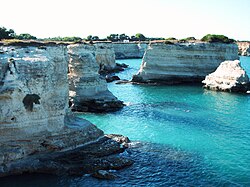
Cenozoic
Third era of the Phanerozoic Eon (66 million years ago to present) / From Wikipedia, the free encyclopedia
Dear Wikiwand AI, let's keep it short by simply answering these key questions:
Can you list the top facts and stats about Cenozoic?
Summarize this article for a 10 years old
The Cenozoic (/ˌsiːnəˈzoʊ.ɪk, ˌsɛn-/ SEE-nə-ZOH-ik, SEN-ə-;[1][2] lit. 'new life') is Earth's current geological era, representing the last 66 million years of Earth's history. It is characterised by the dominance of mammals, birds and flowering plants. It is the latest of three geological eras, preceded by the Mesozoic and Paleozoic. The Cenozoic started with the Cretaceous–Paleogene extinction event, when many species, including the non-avian dinosaurs, became extinct in an event attributed by most experts to the impact of a large asteroid or other celestial body, the Chicxulub impactor.
| Cenozoic | ||||||
|---|---|---|---|---|---|---|
66.0 – 0 Ma | ||||||
 | ||||||
| Chronology | ||||||
| ||||||
| Etymology | ||||||
| Name formality | Formal | |||||
| Nickname(s) | Age of Mammals | |||||
| Usage information | ||||||
| Celestial body | Earth | |||||
| Regional usage | Global (ICS) | |||||
| Time scale(s) used | ICS Time Scale | |||||
| Definition | ||||||
| Chronological unit | Era | |||||
| Stratigraphic unit | Erathem | |||||
| Time span formality | Formal | |||||
| Lower boundary definition | Iridium enriched layer associated with a major meteorite impact and subsequent K-Pg extinction event. | |||||
| Lower boundary GSSP | El Kef Section, El Kef, Tunisia 36.1537°N 8.6486°E / 36.1537; 8.6486 | |||||
| Lower GSSP ratified | 1991 | |||||
| Upper boundary definition | N/A | |||||
| Upper boundary GSSP | N/A | |||||
| Upper GSSP ratified | N/A | |||||
The Cenozoic is also known as the Age of Mammals because the terrestrial animals that dominated both hemispheres were mammals – the eutherians (placentals) in the northern hemisphere and the metatherians (marsupials, now mainly restricted to Australia and to some extent South America) in the southern hemisphere. The extinction of many groups allowed mammals and birds to greatly diversify so that large mammals and birds dominated life on Earth. The continents also moved into their current positions during this era.
The climate during the early Cenozoic was warmer than today, particularly during the Paleocene–Eocene Thermal Maximum. However, the Eocene to Oligocene transition and the Quaternary glaciation dried and cooled Earth.